David Shiman was Judy's Great-Grandfather, Millie Shiman her Grandmother.
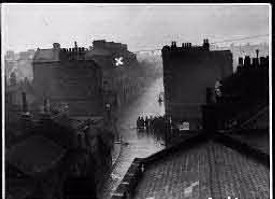
Sidney Street during the Siege during the siege. X (above) marks the location of No.100.
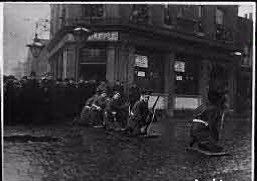
The Shimans in Sidney Street, 1911
In the early years of this century the East End of London provided a haven for political agitators fleeing from, and struggling to overthrow, the Tsarist regime in Russia. They could move freely among the crowded immigrant Eastern European communities that had become well-established. Some of the political exiles sought to fund their activities through ‘expropriation’, by which was understood robbery, often violent. Others, less motivated by politics, found expropriation to be a convenient and lucrative way of supporting themselves.
Shortly before midnight on Friday 16 December, 1910 unarmed police were investigating suspicious noises that appeared to be coming from 11, Exchange Buildings, Houndsditch. They disturbed a gang of several men and at least one woman who were attempting to break into H.S. Harris’s jewellery shop that backed onto Exchange Buildings. Several members of the gang were armed with pistols with which, as they escaped, they opened fire. Three policemen, Sergeant Bentley, Constable Choate and Sergeant Tucker, were shot dead, two other policemen were wounded.
In the confusion one of the gang, George Gardstein, was seriously wounded in the back by one of his fellows. He was carried to a house, 59, Grove Street, some half a mile from Exchange Buildings. Here, early the next morning, he died.
It now seems clear that those members of the gang most seriously implicated, and those with the means, fled abroad within hours. One of these is likely to have been the mysterious Peter Piatkow, known as Peter the Painter. Others relied on their network of friends and associates to hide them in the teeming East End, where policing was widely regarded as difficult and English little spoken, until the furore following the Houndsditch incident had died down.
However it was not long before the police learned of Gardstein’s death. A search of the room in which he died yielded a loaded pistol, a variety of ammunition and many incriminating papers. As a result a £500 reward was posted for Peter the Painter, who was one of the 59, Grove Street tenants, for Fritz Svaars who had occupied the very room where Gardstein had died, and for an un-named woman who had been seen fleeing with the wounded man.
On 1st January 1911, late in the evening, an informant made a statement at City Police headquarters. Recent research suggests that the informant was Charles Perelman. He was a photographer by trade but he had also previously acted as landlord to several of those involved with the Houndsditch incident gang. It has also been strongly suggested that he was involved in getting at least one member of the gang, Max Smoller, abroad immediately following the incident. It is more than possible that Perelman was, in fact, deeply implicated in the Houndsditch robbery himself.
His information was that Betsy Gershon had come to him seeking help for two men, William Sokoloff (usually known as ‘Joseph’ or ‘Yoska’) and Fritz Svaars, who had gone into hiding following the murders. Perelman volunteered assistance, apparently as a pretext to find out where the men were. He offered to visit them to arrange a further hiding place. Betsy Gershon told him that the men had moved into her lodgings at 100, Sidney Street.
100, Sidney Street was one of a block of ten houses that had been erected as recently as 1900. They were called Martin’s Mansions after the local property tycoon to whom they belonged, Charles Martin. They each had three main floors below a spacious attic. Since the time when the house had been built, number 100 had been leased to a ladies’ tailor named Samuel Fleischmann. With his wife, Rebecca, he occupied the front room on the ground together with the middle room on the first floor where their two children slept. He operated his business from the attic and also used one of two second floor rooms as a stockroom. He sub-let the rest of the house.
The middle room on the ground floor was occupied by an elderly couple, the Clements. The other two rooms on the first floor had, for nearly four years, been let to David Shiman, a ladies’ tailor originally from Russian Poland. He slept in the front room with his wife, Fanny, and two infant children, Harry and Jack. Two older children, Simi and Millie, slept in the back room. The remaining room at the front of the second floor had, for the past eighteen months, been rented to Betsy Gershon.
By mid-day on Monday 2nd January the information had been passed to Detective Inspector Wensley, veteran of the Jack the Ripper case, who was playing a leading role in the investigation of the Houndsditch incident. Late on that same afternoon two large horse-drawn vehicles concealing armed policemen were driven into Sidney Street and the house placed under observation. Gradually, as the evening wore on, more police were brought into the area, covering both the front and back of the terrace. Four policemen were stationed in number 98, a doctor’s surgery, and in number 102. By 2 a.m. the some 200 officers were forming a cordon cutting off any possibility of escape. Within the next hour further dispositions were made placing armed men in the shop doorways facing the house.
In the meantime Detective Inspector Wensley enquired of the neighbours as to the ‘respectability’ of the regular occupants of number 100. Having satisfied himself that, with the possible exception of Betsy Gershon, all were most likely to be innocent of any criminal involvement, it was agreed that efforts should be made to evacuate the house. It was also established that the Fleischmanns slept in the front room on the ground floor.
A police interpreter knocked on the shutters. After a period of understandable confusion with the interpreter being mistaken for the milkman, the Fleischmanns were taken into number 102 and questioned by the police about the layout of the house and the whereabouts of the other tenants.
It was first decided to see if it was possible to lure Betsy Gershon out. Samuel Fleischmann, a nervous man, refused to play any part in this. Rebecca Fleischmann, however, showed considerable courage in returning to number 100, and ascending to the second floor. Here she found Betsy, not in her bedroom, but in the stockroom. She persuaded Betsy to come downstairs with her on the pretext that Samuel had been taken ill.
When they reached the ground floor Betsy was seized by the police and carried bodily into number 102. After first denying there was anybody staying in her room, she soon admitted that a close friend of her husband, Joseph Sokoloff, was in fact there. She also reported the presence of a second man, his friend, Fritz Svaars. It subsequently became clear that Joseph, in the absence of Betsy’s husband who was convalescing abroad, had become her lover and had been a frequent visitor at number 100 over the previous months.
She claimed that the men had called only on the previous evening, had refused to leave when asked, had taken away her skirt and boots so that she could not run for help, had threatened her with violence, and told her to sleep on an old sofa in the stockroom. The police, satisfied that they had established that the two men were indeed in the house, arranged for Betsy Gershon to be taken to City Police headquarters forthwith.
There remained the problem of evacuating the Fleischmanns’ children, the Shimans and the Clements. Rebecca Fleischmann went back to the house and shortly returned with her children. A third time she returned, this time awakening the Shimans with the chilling news that there were murderers in the house and that they should leave quickly and quietly. Rebecca picked up the two Shiman babies and carried them downstairs while David and Fanny awoke the other two children and brought them out.
It was hard to persuade Mr. Clement, ninety years of age, to leave. His wife left readily enough, but Mr. Clements had to be forced into his clothes and carried out against his will by David Shiman and others. It is only fair to report that Samuel Fleischmann, who by this time seemed willing enough to enter the ground floor of his house, assisted with this. In the course of this unceremonious removal a police whistle was blown, Mr. Clements started shouting and general clamour broke out. It was reasonably assumed that the two wanted men must have realised that they had been discovered.
The police had decided it would be foolish to tackle the two men while it was still dark. After all the suspects had, they thought, already shot down a number of police officers with appalling ruthlessness. An assault up the narrow and twisting stairs would probably end with carnage. Instead it was decided to do nothing until dawn. Two policemen opened the front door wide. David Shiman crept into the hall-way and turned up the gas lighting. The besiegers settled down to wait for first light.
The weather was cold with occasional flurries of sleet and snow. At about 6.45 a.m. a policeman keeping watch from across the street reported the opening and closing of the door to the Shiman’s front room on the first floor. Some three-quarters of an hour later, as it began to get light, it was decided to attract the wanted men’s attention with a view to inviting their surrender.
After the understandable caution that had attended so much of the night’s activity, the casual manner in which this was attempted seems curious. First a policeman rushed across the road, banged loudly on the open door, then ran back. There was no response. A group of senior officers, including Inspector Wensley and Detective Sergeant Leeson, then started throwing pebbles at the windows of the front second floor room where the men were supposed to be sheltering.
Abruptly a window in the Shiman’s front room shattered as a volley of shots was fired into the street at the group of policeman. Sergeant Leeson fell, shot in the chest and right foot. As police concealed in entrances and buildings opposite returned fire, Sergeant Leeson was dragged to cover by his colleagues.
The story of the Sidney Street gun battle is too well known to bear detailed repetition here. The numerous but inadequately armed police were soon reinforced with regular troops. In the early stages of the siege Svaars and Sokoloff moved freely about the house firing from both front and rear windows. They responded aggressively to any target that presented itself.
The Home Secretary, Winston Churchill, came onto the scene and controversially assisted in the direction of the siege. In all it was estimated some 2000 rounds were fired of which the two wanted men contributed some 400. Amazingly, with the exception of Sergeant Leeson who eventually recovered from his wounds, nobody among the many hundreds of besieging police, troops or bystanders was seriously injured.
The positioning of military marksmen high in the cooling tower of a brewery opposite eventually largely restricted Svaars and Sokoloff to the first floor and lead to furious exchanges of fire across the street.
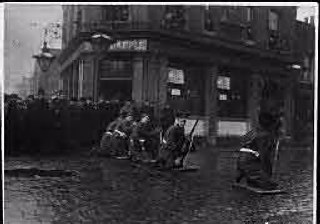 Marksmen take up position.
Marksmen take up position. 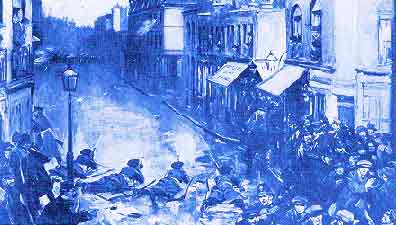
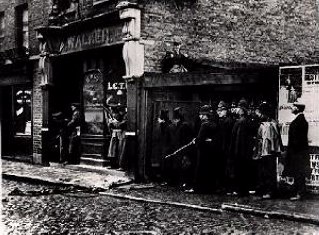 Winston Churchill at Sidney Street
Winston Churchill at Sidney StreetAll this while the evacuees were sheltering in number 102 where, in spite of the continuous noise of shooting, Sokoloff and Svaars could occasionally be heard shouting to each other next door. The refugees were gathered in the middle ground floor room with its window barricaded. A Daily Chronicle reporter later wrote that the scene in number 102 was “a pathetic [one] of squalor and hysterics, and noisy with a perpetual babble of Yiddish protest”.
The beginning of the end came at 12.50 p.m. when smoke was seen rising from number 100. It was later established with a fair degree of certainty that the two besieged men had started the fire at the top of the house themselves. It appears to have been a desperate attempt to create a source of confusion in which they could make their escape.
The fire and ever-thickening smoke gradually spread downwards over the next hour. Unused ammunition could be heard exploding. The last shots from the front of the house were fired through the window of the Fleischmann’s front room on the ground floor at 1.50 p.m. Shortly afterwards it was thought that nobody could still be alive in the blazing house and waiting firemen were called in.
However this development provoked a final defiant volley of four shots from the rear of the house causing the firemen to withdraw until 2.40 p.m.
Two charred bodies were recovered. Joseph Sokoloff had been shot in the head, apparently while standing at the window of Millie and Simi Shiman’s room. Fritz Svaars had been asphyxiated by smoke on the ground floor. Two Mauser pistols were found under his body.
The police and troops left the scene, satisfied that Svaars and Sokoloff had received their just deserts. For the other inhabitants of 100, Sidney Street the incident had been an unrelieved disaster. The building was gutted with virtually every scrap of clothing, furniture, tailoring equipment and business stock destroyed.
Although the closely knit community came to their aid, the Shiman’s were obliged to separate. Fanny and two children were taken in by one neighbour, the other two children by a second. David Shiman was, it seems, put up by his employer, Isaac Levene at 30, Sidney Square.
It was widely accepted that the innocent victims of the affray had a right to compensation, but it was unclear how this redress should be made, and who should pay. At an early stage David Shiman made a statement detailing his family’s circumstances and passed it to the police authorities. This document is preserved in the Public Record Office, Kew. I reproduce it here in full:
P.R.O./MEPO/5/110: S. St. Fin - Compensation Claims.
Statement taken at 30, Sidney Square on January 10th 1911. Re. fire at Sidney Street, Tuesday January 3rd 1911.
Mr. Davis Schieman had occupied two rooms on the first floor for the past 4 years, paying a rental for same of 7/6 per week to Mr. Fleischmann. He came to London from Russian Poland 9 years ago. He worked for B. Kososky at 298, Commercial Road for nearly 5 years, but for the last 3 years has worked for Mr. Isaac Levene at 30, Sidney Square (as a Ladies’ Tailor) earning an average of 45/- per week. He has a wife and four children, their ages ranging from 1½ yrs. to 11yrs. The two eldest children are scholars @ Baker Street School.
At 3am. on the 3rd January he was aroused by Mrs. Fleischmann, who said they must all get up and leave the house, as there were “two murderers upstairs”. He and his wife and children, but scantily clad, at once came downstairs; he asked a detective at the door what he was to do about his things upstairs, when he assured him “everything would be quite safe” and they were hurried into No.102 Sidney Street (next door) where they were kept until 6pm. the same day. He went (in company with Mr. Fleischmann) to Arbour Square Police Station the following afternoon, to know what he was to do, as he had lost absolutely everything, through the destruction of the premises, but was told by the Inspector on duty that he could give him no advice in the matter.
He is now without a home of any kind, shelter being provided for his wife and two children by one neighbour, for the other two children by the second and for himself by a third. He has prepared a list of the furniture, clothing etc. which he has lost and estimates the value of same at £133.
He has never been connected with any political society or club, but is a member of two sick benefit societies, viz:
Lodge 8, The Ancient Order of Israel
Meeting at the Cannon Street Road Synagogue
and the
“Brothers of Joseph”
meeting at 19, Whitechapel Road.
Statement taken by William Groves and verified by Mr. I. Levene.
***
It is understandable, given the climate of suspicion engendered by Eastern European political exiles, that David Shiman should pointedly deny any connection with any of the revolutionary political clubs that operated openly in the locality.
The plight of the Shimans, and their fellow tenants, was raised in the House of Commons early in March. By the end of the month Winston Churchill was able to announce that he had appointed two MPs, Sir Henry Dalziel and Alpheus C. Morton, to head a formal Compensation Board. The Board was authorised to make payments “as a matter of grace” from police funds.
Sadly the Public Record Office preserves a typescript of only one day’s proceedings of the Compensation Board; that of the second day when evidence was rigorously examined from the Fleischmanns, Betsy Gershon and the owner of the house, Charles Martin. David Shiman’s verbatim evidence is missing. However, the Sidney Street incident was still attracting much public interest and the hearings were widely reported in the press.
It seems that David Shiman, in claiming his £133 compensation, told of his part in the evacuation of the house, recounted the death of his wife and reported that after the fire the only items of his property that he could identify were broken cups and plates.
In the end the Shimans were awarded just £65. In this, relatively speaking, they did better than the Fleischmanns; Samuel had claimed £907.11s.7d but was awarded less than £300. Betsy Gershon, incidentally, claimed £75.4s.6d but was given nothing; it was widely held that she was fortunate not to have been charged as an accessory.
A more significant improvement in David Shiman’s fortunes, and those of his children, occurred a short while later when he re-married. His second wife was Fanny’s sister, Rachel.
Another official payment had already been made. As Charles Perelman’s information had led to just one of the three individuals on the £500 reward poster, Fritz Svaars, it was deemed that he was entitled to exactly one third of the reward. He received £166 .13s. 4d.
Three men and two women, regarded as being members of the gang who had planned and participated in the Houndsditch robbery, stood trial. Eventually all were acquitted by virtue of the thinness of the evidence against them. It became clear during these court proceedings that at least some of the main perpetrators had got clean away. Nevertheless it was comfortably assumed by the authorities that Svaars, Sokoloff and the accidentally shot Gardstein were those principally involved in the murder of the policemen. The same conclusion was gratefully seized upon by others suspected of criminal involvement.
Recent investigations, however, have tended to show there is at least room for doubt. Donald Rumbelow in his The Houndsditch Murders and the Siege of Sidney Street makes a good case for neither Fritz Svaars or Joseph Sokoloff being at Exchange Buildings when the policemen were shot. He reasons that they were part of a second team of burglars waiting at Grove Street to take over from the first once they had breached the back wall of the jewellers. Sokoloff was by trade a jeweller and might well have provided the expert information that lead the gang to target H.S. Harris’s shop.
Donald Rumbelow also discovered in police records a letter that had been handed by Fritz Svaars to Charles Perelman at 100, Sidney Street for it to be forwarded to his family in Latvia. Instead Perelman, as part of his betrayal, had turned it over to the police. This letter protests Svaars’ innocence but acknowledges the likelihood that, if apprehended, both he and Sokoloff would be hanged. “I know that if they get hold of me they’ll hang me anyway and for that reason I am going to resist and will even shoot myself”.
Another of the many loose ends and unresolved problems associated with the Sidney Street Siege is the issue of how long, and with what degree of compliance, Betsy Gershon had been sheltering the fugitives at number 100. Naturally, in the face of official enquiry, she maintained that they had been there only a matter of hours. There is, however, evidence that the men had been hiding there much longer. Indeed, Charles Perelman’s information was that they had arrived on 17th December immediately after the Houndsditch murders.
A curious incident was reported to Rebecca Fleischmann by David Shiman. On the morning of Sunday 1st January it appears that his daughter, Millie, had surprised a ‘thief’ in his room. Mrs. Fleischmann also recollected smelling tobacco smoke at the top of the house on the same day, although none of the house’s regular tenants smoked. There is also the curious story of August Maren.
Maren was certainly connected with the Houndsditch expropriators. He appears in one of the photographs discovered at Fritz Svaars’ lodgings in Grove Street. He found it convenient to leave for Australia early in February 1911, three days before police following up Houndsditch incident enquiries raided his lodgings. Before he left he was apparently a badly shaken man, telling friends that he was being sought by the police. However, as the ship sailed further South his confidence was renewed and he boasted of his knowledge of the expropriation gang. He claimed that, following the bungled robbery, two of the gang “had gone to a house where the group stored its fighting and burglary instruments, until a fight with the soldiers had broken”. This would certainly account for the prodigious quantity of ammunition fired by the fugitives during the siege and suggests that Betsy Gershon may have been more deeply involved than she cared to admit.
A Note on Sources.
Two books give detailed accounts of the Sidney Street Siege and surrounding incidents. These are Colin Rogers, The Battle of Stepney and Donald Rumbelow, The Houndsditch Murders and the Siege of Sidney Street. Both come to very different conclusions regarding the course of events. The Public Record Office holds a fascinating file of documents mainly relating to claims for compensation. Phyllis Wayne kindly provided and confirmed a number of details. Contemporary issues of The Times give much space to official proceedings and transactions, but are short on human detail.
I believe that coverage in other newspapers, both national and local, was understandably extensive, but I have yet to have the opportunity of pursuing this avenue. I understand there is much material to be found in The Daily Telegraph, The Morning Post and The Morning Chronicle. In particular it would be interesting to track down reports of David Shiman’s evidence to the Compensation Board.
A Note on Names.
The story of the Sidney Street Siege is both complex and confused. The confusion is not helped by the variety of names associated with virtually every participant. There are various reasons for this. In the first place those taking down Eastern European names, either for official purposes or for the press, found them unfamiliar. Thus David Shiman appears variously as David (or Davis) Schiemann, Sheinmann, Sheismann or Schiesbann. Other names were in the process of assimilation. Thus the grandson of Mrs. Bluestein (or Blustein), the landlady of 102, Sidney Street, achieved fame as the broadcaster, Rabbi Lionel Blue.
Another reason for the multiplicity of names is more sinister. Many of the political émigrés had good cause to conceal their identities. Many carried passports in more than one name. Some even shared aliases. Those who engaged in criminal activity had even more need of caution. For example Fritz Svaars was also known as Karl Davidoff Dumnieks, Louis Lambert and Peter Trohimtchick. George Gardstein, the gang member fatally wounded at Exchange Buildings, was also called P. Morin, Poolka Mourrewitz or Mourremitz or Mouremtzoff, and, anglicised, as George Garstin. Furthermore he carried passports in the names of Schafshi Khan and Yanis Karlowitch Stentzel.
Under these circumstances alone it is unlikely that the full story will ever be known.